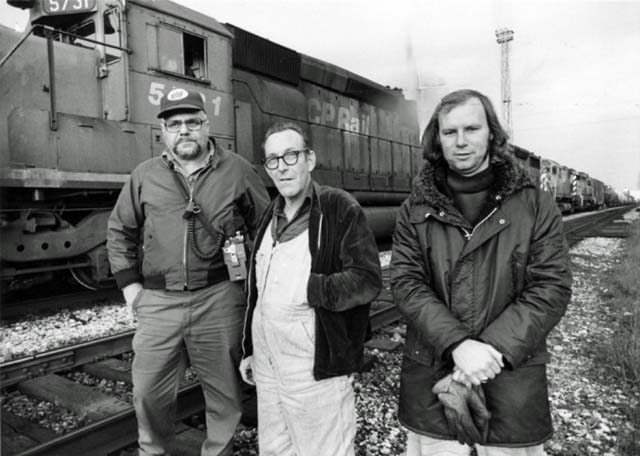
as the Mississauga Miracle
Mississauga Ontario - The city of Mississauga was asleep as disaster hurtled toward it at 80 km/h on the night of 10 Nov 1979.
About 40 kilometres from the city centre, Canadian Pacific Train 54 loaded with explosive and poisonous chemicals developed a "hot box," railway
slang for an overheated mechanism that houses a wheel bearing.
As the eastbound 106 car freight train approached Mavis Road (north of Dundas Street West) a few minutes before midnight, a rear axle and two wheels broke
off, causing 24 cars to derail, propane tankers to explode, and others to catch fire.
Sandwiched in the middle, a tanker carrying 90 tonnes of liquid chlorine became a ticking time bomb, throwing the entire city into chaos and triggering the
biggest exodus of potential casualties, 240,000 people, in Canadian history.
The crew at the Fairview Road fire station was about to turn in that Saturday night when "we hear an ominous rumble," recalled a firefighter in a
chronology by Toronto Star rewrite reporter Nicolaas van Rijn.
"And as I look out the window the sky turns red with flames. I know right off it's a biggie."
John and Lynne Riddel's home was mere metres from the tracks.
When a red-hot set of train wheels crash-landed in their backyard they knew something was seriously amiss.
"I'm lucky the whole train didn't end up on my house," John said, surveying the charred object later.
As explosions sent shock waves 50 kilometres and flames reached 40 storey heights, yellow clouds of chlorine gas, the stuff that killed thousands of soldiers
in the First World War, belched into the air.
Risking his life, trainman Larry Krupa raced to uncouple two tankers so dozens of freight cars could be pulled away.
But no one knew the full scope of the danger or the complete inventory of hazardous materials on the train.
Firefighters had to brave the conflagration to read chemical code numbers on the tankers for butane, toluene, caustic soda, and other flammable materials,
recalled Mississauga Fire Chief Gord Bentley.
The biggest fear centered around the leaking chlorine tanker.
Had it blown apart, the liquid would have turned into deadly vapour forming a knee-high cloud that would kill or maim everything in its path.
As the magnitude of the peril became clear, hundreds of emergency responders, officials, and experts were mobilizing across southern Ontario.
Ninety minutes after the first alarm, police officers in gas masks began to rouse residents with the help of an ambulance cruising the streets with a
loud-hailer.
Other cops from the 700 strong team amassed from four forces directed traffic along the congested routes to safety.
And humanity put its best foot forward.
"We had calls from firemen and ordinary members of the public offering to drive vehicles for us," said ambulance area supervisor Russ
Ascott.
"That was the most heartening part."
While carloads of dazed and frightened families raced to evacuation centres in labour halls, schools, and church basements, others just fled into the
night.
Four young girls from a slumber party less than a kilometre from the blast "panicked and vanished," according to their host Barb
Horan.
"They were screaming and crying, they thought the house was on fire. The windows lit up and shook like crazy."
As firefighters struggled to control the blaze and winds shifted, the danger zone expanded, forcing more people to flee, some two and three times.
The massive International Centre on Airport Road became a temporary home to thousands, businesses and factories shut down, GO trains were halted, and
health care institutions emptied.
At the core of the evacuation process were Dow Chemical Company computers which ran doomsday programs and spewed ever-changing forecasts.
"We have 90 tonnes of chlorine slowly leaking out," explained Peel Region Police Chief Doug Burrows.
"We have to know where it could go under different weather conditions. We have to know about every possible circumstance, in advance."
The massive migration continued with a fleet of 100 ambulances transporting 2,000 people, including women in labour and unconscious patients with medical
charts strapped to their stomachs.
At Mississauga General Hospital, staff took just 3 1/2 hours to discharge or move all 462 patients to eight other locations, turning the bustling medical
centre into a silent shell.
Grim faced war veterans wearing Remembrance Day poppies were wheeled out of nursing homes.
"I saw an awful lot of men die," said 88-year-old William Johnson, who witnessed chlorine gas clouds at Ypres in 1914.
But amid the chaos came moments of levity.
An elderly gentleman being carried onto a bus was asked by a reporter where he was going.
"To heaven, I hope," he chuckled.
At St. Joseph's Hospital, which welcomed an influx of 11 displaced moms and their newborns, clerk Terry Landry laughed as an ambulance driver "walked in
holding a baby under each arm."
For bleary-eyed refugees, the drama was "like some bad dream, but I haven't slept enough to dream," complained William Higgins, whose family was
"shunted from pillar to post" after the blasts.
Just over 24 hours after the evacuation began at 01:30, Sunday, Canada's ninth largest city was a ghost town.
It would be six days before all evacuees, most of Mississauga's residents as well as pockets from Etobicoke and Oakville, could return home.
Beyond a few birds and a tankful of tropical fish there were no casualties, earning the near-catastrophe the moniker "Mississauga
Miracle."
The event spurred changes in the rail transport of hazardous goods, including inspections and speed reductions near large communities, the use of
heat-resistant roller bearings, and "hot box" detectors.
Mississauga became a model for crisis management for its efficient and speedy response.
But the city of 250,000 experienced the narrowest of escapes, as a thankful Mayor Hazel McCallion expressed, "A half mile farther down on the track... we
would have seen thousands of people wiped out."
Carola Vyhnak.
under the provisions in
Section 29 of the Canadian
Copyright Modernization Act.


